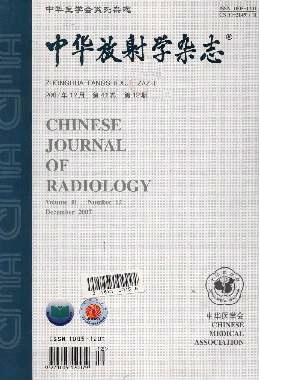Feasibility study of the multi-slice dual-source CT double turbo flash mode for one-step coronary and carotid-cerebrovascular CT angiography in patients with heart rate variability
Q4 Medicine
Zhonghua fang she xue za zhi Chinese journal of radiology
Pub Date : 2020-02-10
DOI:10.3760/CMA.J.ISSN.1005-1201.2020.02.002
引用次数: 1
Abstract
Objective To investigate the feasibility of one-step coronary and carotid-cerebrovascular computed tomography angiography (CTA) using high-pitch Double Turbo Flash mode and to analyze the image quality and radiation dose in patients with heart rate variability using multi-slice detector dual-source CT. Methods A total of 79 patients with heart rate variability higher than 3 beat/min (bpm) were retrospectively analyzed. They were grouped by the scanning methods. Group A (n=40) were performed double turbo flash mode for one-step coronary and carotid-cerebrovascular arteriesinjected with one injection of contrast agent.further divided into Single A (only the phase 1 image)and Double A(combined images of phases 1 and 2). Group B (n=39) were performed separately with twice injection of contrast agent. Subjective scoring was performed on the image quality of the group Single A, Double A and B using a 4-point. Then the objective parameters of image quality, CT attenuations, image noise, signal-to-noise (SNR), and contrast-to-noise (CNR), were evaluated. Then subjective scores, objective evaluation indicators, and radiation dose were compared with one-way ANOVA analysis among the three groups.Contrast agent were compared by using t test in group A and B. Results No significant difference was found (F=2.093, P=0.128) for the subjective scores of the head and neck CTA among the three groups with (3.47±0.51), (3.53±0.51), (3.69±0.47). Significant difference was found (F=50.955, P 0.05), met the requirements for diagnosis; the differences in SNR and CNR of coronary CTA images are statistically significant (F=12.991, 12.236, P 0.05), met the requirements for diagnosis. Radiation dose in the group Double A was lower than group B (decreased by 46.15%,P<0.01).The amount of the contrast agent in the group Double A was lower than group B (decreased by 44.13%, t=-45.455;P<0.01). Conclusion The double turbo flash mode is feasibility for one-step coronary and carotid-cerebrovascular CTA in patients with the heart rate variability using multi-slice dual-source CT.This scan mode can maintain the diagnostic image quality with low contrast agent and radiation dose. Key words: Tomography, X-ray computed; Coronary vessels; Cerebrovascular circulation; Image quality; Radiation dosage; Heart rate多层双源CT双涡轮闪影模式对心率变异性患者进行一步冠状动脉及颈脑血管CT血管造影的可行性研究
目的探讨高频双Turbo Flash模式下一步冠状动脉和颈动脉计算机断层成像(CTA)的可行性,并利用多层探测器双源CT分析心率变异性患者的图像质量和辐射剂量回顾性分析。他们按扫描方法分组。A组(n=40)对一次注射造影剂的冠状动脉和颈动脉进行双涡轮闪光模式。进一步分为单A(仅1期图像)和双A(1期和2期的组合图像)。B组(n=39)分别注射两次造影剂。使用4分对单A、双A和B组的图像质量进行主观评分。然后对图像质量、CT衰减、图像噪声、信噪比和对比度等客观参数进行了评估。然后用单因素方差分析比较三组患者的主观得分、客观评价指标和辐射剂量。结果三组头颈部CTA主观评分分别为(3.47±0.51)、(3.53±0.51,(3.69±0.47),差异无统计学意义(F=2.093,P=0.018),符合诊断要求;冠状动脉CTA图像的信噪比和CNR差异具有统计学意义(F=12.99112.236,P<0.05),符合诊断要求。双A组放射剂量低于B组(下降46.15%,P<0.01),造影剂用量低于B组,下降44.13%,t=-45.455,P<0.01扫描模式可以在低造影剂和低辐射剂量的情况下保持诊断图像质量。关键词:体层摄影、X射线计算机;冠状血管;脑血管循环;图像质量;辐射剂量;心率
本文章由计算机程序翻译,如有差异,请以英文原文为准。
求助全文
约1分钟内获得全文
求助全文
来源期刊

Zhonghua fang she xue za zhi Chinese journal of radiology
Medicine-Radiology, Nuclear Medicine and Imaging
CiteScore
0.30
自引率
0.00%
发文量
10639
 求助内容:
求助内容: 应助结果提醒方式:
应助结果提醒方式:


